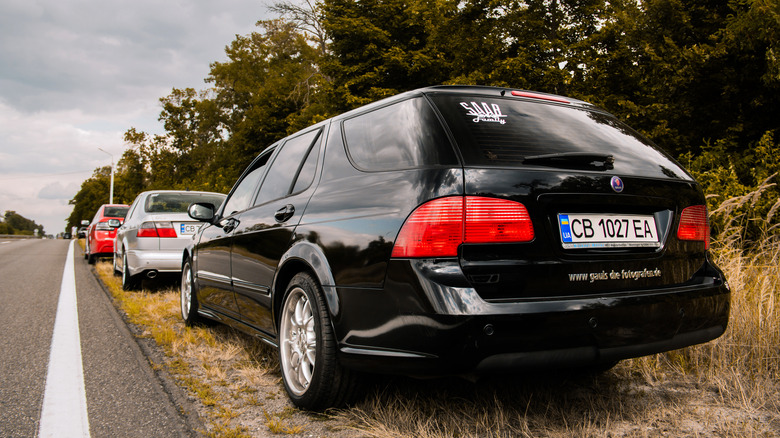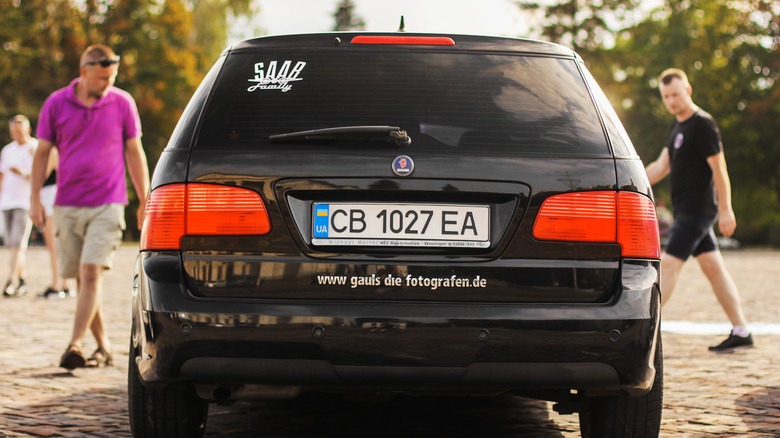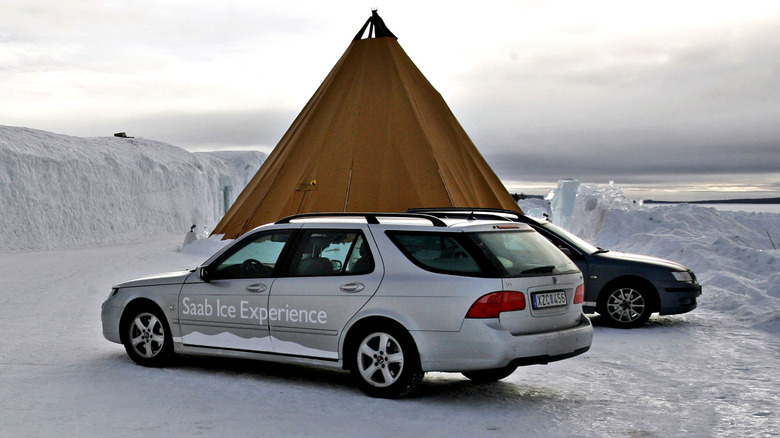Why One Of The Last Saab Models Ever Made Is Banned In America
While Saab may not be around today, it lives on in auto enthusiasts' hearts. Saab was a quintessentially Swedish brand famous for its unique cars. Among the most popular models from the company include the Saab 900, a quirky compact sedan that had a dream run through the '80s and the early '90s but is now almost extinct. Then there's the Saab 99 Turbo, the company's first-ever turbocharged model, and the Saab 9000 Aero, known for its sublime 2.3 liter, 225 bhp turbocharged motor. Besides being highly sought after by auto fans, Saab also had significant popularity in the U.S., unusual for a European car company (via CarSalesBase).
Initially owned by Saab AG — an aeronautics and defense company that continues to exist today — Saab's ownership has changed several hands since 1945. In 1968, the company was merged with Swedish truck maker Scania before being taken over by General Motors through the '90s and the 2000s.
Saab's fortunes took a turn for the worse in 2010 after GM attempted to sell the company to Spyker NV — a little-known Dutch company (via Business Standard). The deal eventually fell through and Saab filed for bankruptcy in 2011. During the proceedings, Saab still had several models in the pipeline. One of these models was the Saab 9-5 SportCombi — scheduled for launch in 2012. Today, however, this car is more famous for being the only Saab vehicle that was banned from being sold in the U.S.
Why was the Saab 9-5 SportCombi banned in the U.S.?
Scheduled for release in 2012, the Saab 9-5 SportCombi was first showcased at the 2011 Geneva Motor Show — a luxury crossover of sorts and a station wagon derivative of Saab's popular executive car, the Saab 9-5. Even before its announcement, there was considerable interest in the 9-5 SportCombi, and Saab expected them to sell well. However, things didn't exactly go as Saab planned.
Despite plans to launch the Saab 9-5 SportCombi in the U.S., the car was never officially released there. Several rumors claim that the SportCombi did not pass the required safety testing standards (like what really did happen with the Land Rover Defender). The truth, however, is more complicated. Saab was in the process of bringing the 9-5 SportCombi to market, but their bankruptcy proceedings meant that the cars never made it past the prototype phase (via SaabBlog). In fact, the model never even made it to the assembly line, meaning that the few examples in existence today are all prototypes.
For any manufacturer to sell cars in Europe and the U.S., the vehicles must possess a document known as the "Certificate of Conformity" (CoC). This certification is granted after the manufacturer subjects the car to multiple tests. Because the 9-5 SportCombi never went beyond the prototyping phase, the car was never granted a CoC document, which means all existing prototypes of the car are illegal to drive on European and U.S. roads.
The Saab 9-5 SportCombi is banned in Europe too
Years after Saab went through bankruptcy proceedings, 18 prototypes of the 9-5 SportCombi went for auction in Europe. These auctions presented a golden opportunity for Saab fans to own a piece of their favorite company's automotive history. These prototypes were sold under the strict caveat that they would never be driven on public roads in Europe due to their lack of a CoC. Driving a 9-5 SportCombi on a public road was effectively outlawed.
However, a dedicated Saab fan from Sweden was able to go through the painstaking process of self-certifying the 9-5 SportCombi in Europe. After that, he was able to legally drive the car across most of the continent. He has documented the entire process in a lengthy 2013 blog post on Jalopnik. In the course of making the car road legal, he was also able to drive the car for thousands of miles, making him one of the few people to ever drive the car extensively.
The writer's impressions about the car make the post even more interesting. In his review, he described the Saab 9-5 SportCombi as a "great car" with several improvements over its predecessors. He especially loved the car's 1.6T engine that made a little over 180 bhp of power. The Saab 9-5 SportCombi prototype has even drawn a lot of attention from non-enthusiasts, who simply appreciate looking at a rare piece of machinery.


